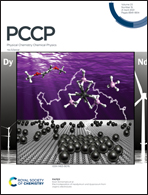Evolutionary structure prediction-assisted design of anode materials for Ca-ion battery based on phosphorene†
Abstract
The utilization of multivalent ions such as Ca(II), Mg(II), and Al(III) in energy storage devices opens up new opportunities to store energy density in a more efficient manner rather than monovalent Li or Na ion batteries. Active research on Ca(II) has been limited due to the low diffusion rate of Ca within the lattice as well as the difficulty of the reversible electrodeposition of Ca in standard electrolytes at room temperature. Herein, using first-principles calculations, we have studied the applications of various allotropes of phosphorene (Pn) as potential materials for Ca(II) battery (CIB). It is seen that among different forms, α and δ phases are suitable to act as anode materials for Ca ion battery. Apart from this, we have also studied the possible formation of various CaxPy phases during the calcination process since it is assumed that during metal insertion and extraction, anodes form non-equilibrium structures. Evolutionary Structure Prediction methods are extensively utilized to determine if the formation of these different CaxPy phases have a significant impact on the anodic performances of Pn or not. It is found that the CaxPy phases formed during the calcination process show reasonable average voltages as well as low volume change and high specific capacity, thus confirming the suitability of Pn as an excellent support for anodes in the Ca(II) ion battery.



 Please wait while we load your content...
Please wait while we load your content...